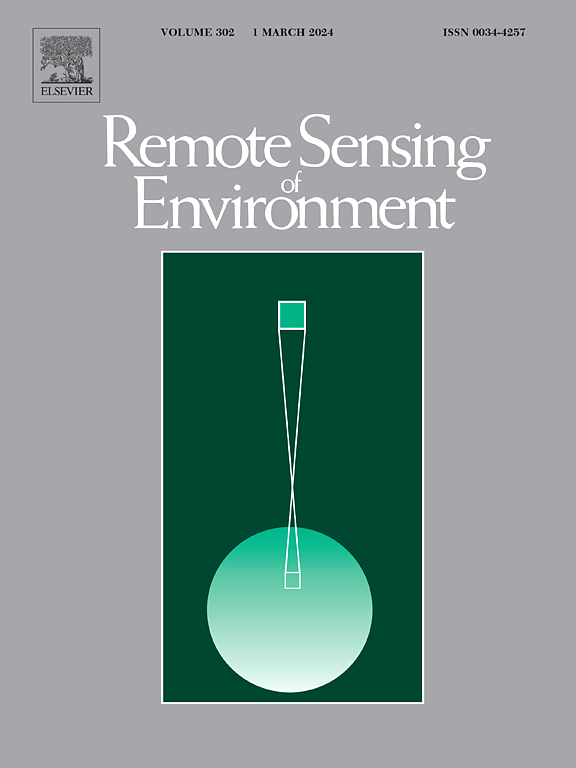Rainfall-caused water film on canopy surface biases remotely-sensed vegetation greenness
IF 11.1
1区 地球科学
Q1 ENVIRONMENTAL SCIENCES
引用次数: 0
Abstract
Remotely-sensed vegetation greenness exhibits obvious differences before and after the short-term heavy rainfall event. This short communication reports that residual water film on the canopy caused by precipitation directly affects the spectral signal of vegetation, which in turn biases observed vegetation greenness. We combined ground measurements, unmanned aerial vehicle (UAV) measurements, three-dimensional radiative transfer model (RTM) simulations, and satellite observations to assess this phenomenon and investigate the impact of water film on vegetation indices (VIs) across different scales and vegetation types. Our findings demonstrate that precipitation exerts a quick and significant influence on the spectral characteristics of canopy components. The presence of water can lead to reflectance attenuation in soil and vegetation components across the entire visible and infrared spectrum, particularly in the near-infrared (NIR) band, with reductions of up to 0.12. The reduction in VI measures after precipitation can be explained by an imbalance in the magnitude of visible and NIR reflectance attenuation caused by the canopy water film. Taking the difference vegetation index (DVI) as an example, the decrease in NIR reflectance is more pronounced than that of red reflectance in the presence of water, resulting in DVI decreasing after a rainfall event. Satellite observations indicated that NDVI and EVI could decrease even exceeding 0.3 in some pixels after short-term rainfall. This work reveals the water film as a possible factor contributing to the bias between true and observed vegetation greenness. The spatial distribution of rainfall seasonality exhibits variation across different regions worldwide, and mitigating the impact of water film on vegetation greenness is essential for enhancing the precision and reliability of global vegetation dynamics monitoring.
降雨引起的冠层表面水膜对遥感植被绿度产生偏差
遥感植被绿度在短期强降雨事件前后表现出明显差异。这篇短文指出,降水造成的冠层残留水膜直接影响植被的光谱信号,进而使观测到的植被绿度出现偏差。我们将地面测量、无人机测量、三维辐射传递模型模拟和卫星观测结合起来,对这一现象进行了评估,并研究了不同尺度和植被类型的水膜对植被指数(VIs)的影响。我们的研究结果表明,降水会对冠层成分的光谱特征产生快速而显著的影响。水的存在会导致土壤和植被成分在整个可见光和红外光谱中的反射率衰减,尤其是在近红外(NIR)波段,衰减幅度可达 0.12。降水后 VI 测量值降低的原因是冠层水膜造成的可见光和近红外反射衰减量失衡。以差异植被指数(DVI)为例,在有水的情况下,近红外反射率的衰减比红外反射率的衰减更明显,导致降雨后差异植被指数下降。卫星观测表明,短期降雨后,部分像素的 NDVI 和 EVI 下降甚至超过 0.3。这项工作揭示了水膜可能是造成真实植被绿度与观测植被绿度之间偏差的一个因素。降雨季节性的空间分布在全球不同地区表现出差异,减轻水膜对植被绿度的影响对于提高全球植被动态监测的精度和可靠性至关重要。
本文章由计算机程序翻译,如有差异,请以英文原文为准。
求助全文
约1分钟内获得全文
求助全文
来源期刊

Remote Sensing of Environment
环境科学-成像科学与照相技术
CiteScore
25.10
自引率
8.90%
发文量
455
审稿时长
53 days
期刊介绍:
Remote Sensing of Environment (RSE) serves the Earth observation community by disseminating results on the theory, science, applications, and technology that contribute to advancing the field of remote sensing. With a thoroughly interdisciplinary approach, RSE encompasses terrestrial, oceanic, and atmospheric sensing.
The journal emphasizes biophysical and quantitative approaches to remote sensing at local to global scales, covering a diverse range of applications and techniques.
RSE serves as a vital platform for the exchange of knowledge and advancements in the dynamic field of remote sensing.
 求助内容:
求助内容: 应助结果提醒方式:
应助结果提醒方式:


